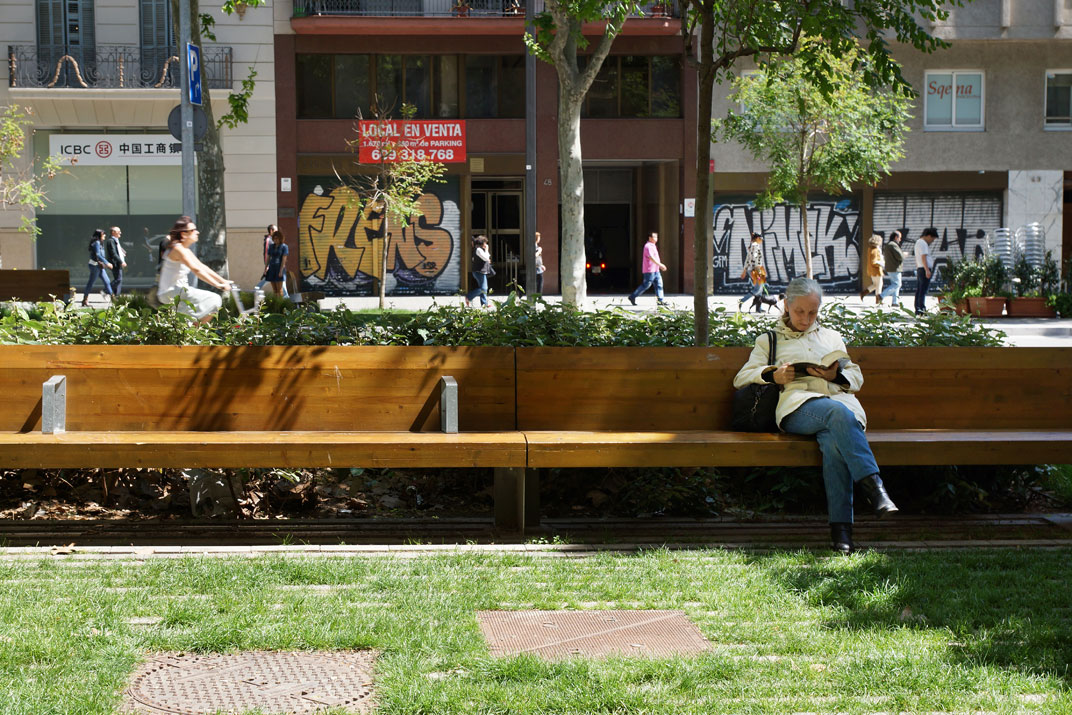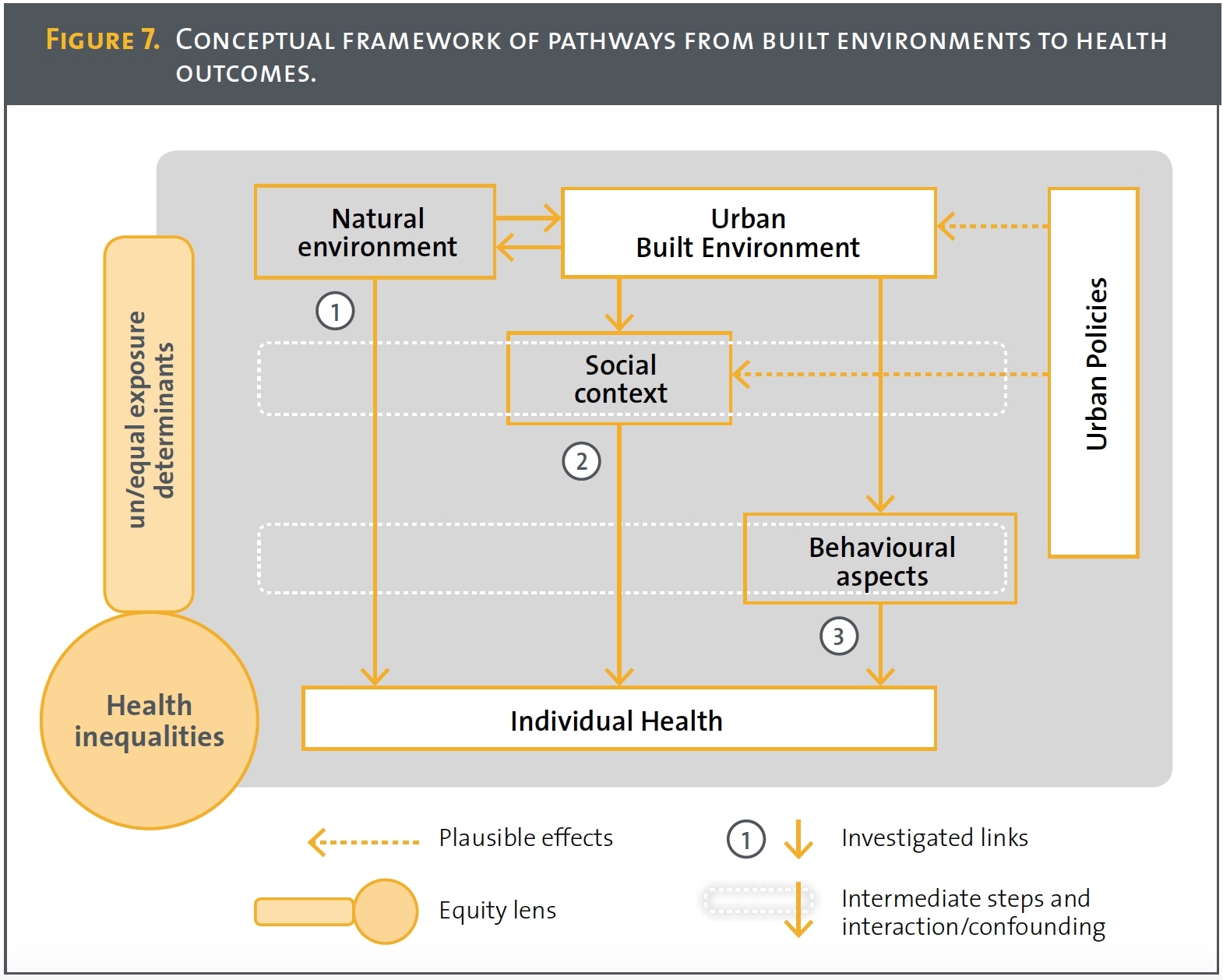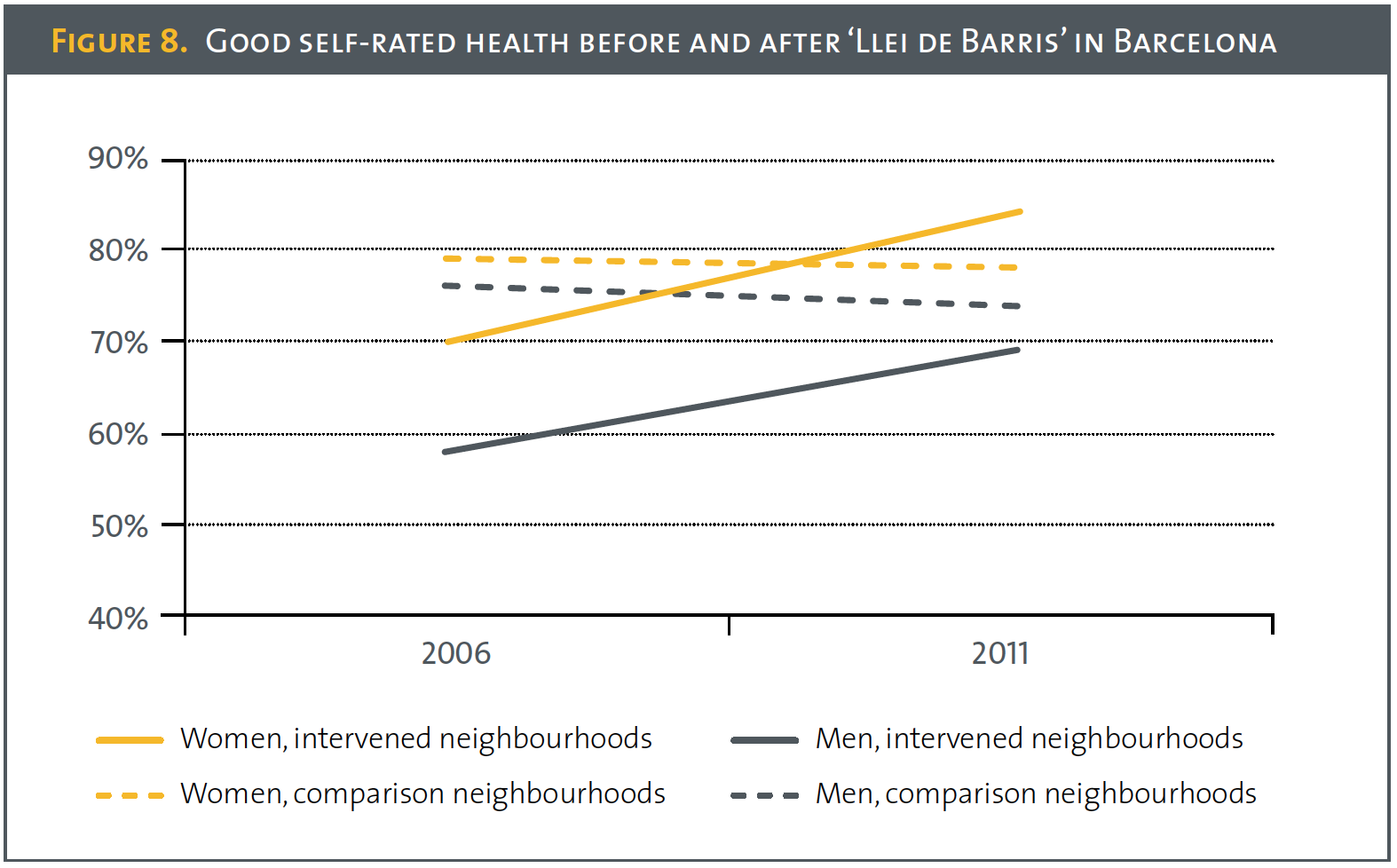Built environment

In 2008, the WHO Commission on Social Determinants of Health stated: "Communities and neighbourhoods that ensure access to basic goods, that are socially cohesive, that are designed to promote good physical and psychological well-being, and that are protective of the natural environment are essential for health equity".
A growing literature has recognised the health disadvantage of residents in socio-economically deprived neighbourhoods, independently on the influence of individual socio-economic conditions. Little is known about the impact on health and health inequalities of urban renewal interventions, and their evaluation has been acknowledged as especially challenging.
Main findings
Social and functional mix, density and accessibility matter when it comes to mortality and mental health
In a selection of European metropolitan areas we conducted a population-based cohort study comparing the mortality (Torino, Barcelona, Stockholm, Helsinki) (1) and antidepressant drug consumption (Torino) (2) of people living in urban areas who were exposed to a different mix of social or physical characteristics as a result of urban structure. We used data from longitudinal studies combined with census data. Exclusively in the case of Torino, we collected and mapped data on urban transformation over the last 30 years.
Urban planning is the main driver for the differential distribution of services and features within a city: planning decisions are intended to modify the main aspects of the built and social environment, recognized as potential determinants of health impacts according to several reviews of scientific literature (3,4,5,6). The relative contribution of these determinants of the social and built environment to the trend towards inequality in mortality in an urban setting (Torino) has been estimated compared to the contribution of individual and social determinants (7,8).
As expected, the individual indicators of social disadvantage show the strongest contribution to inequalities in mortality (8) and mental health (2), but social deprivation in local neighbourhoods also plays a significant and independent role in the risk of premature mortality (8).
This situation may be due to the segregation of populations with low socio-economic status to disadvantaged neighbourhoods, as an unintended consequence of urban transformations and interventions (1).
The study in Torino (2) suggests that this effect may be partially due to the built environment itself. Individuals suffering from minor depressive disorders, a health outcome considered to be of short-term impact, seem to benefit from higher levels of urban density and improved access to public transport. Women and the elderly are most likely to be affected by neighbourhood characteristics and hence report more significant related health impacts. However these features of urban structure (accessibility and density) which have a positive effect on mental health are evenly distributed across social groups in cities and do not contribute to health inequalities, at least in the case of Torino.
We found only few studies in Europe that assessed health inequalities linked to built environments. Results of these studies were highly influenced by the local context, making it difficult to generalize conclusions (5). However local studies remain of prime importance in regards to informing local decision taking based on local evidence.
(1). Marinacci C, Demaria M, Biggeri A, et al. a The role of contextual socioeconomic circumstances and segregation on mortality in four European cities. Forthcoming.
(2). Melis G, Gelormino E, Marra G, et al. The Effects of the Urban Built Environment on Mental Health: A Cohort Study in a Large Northern Italian City Int. J. Environ. Res. Public Health 2015, 12(11), 14898-14915.
(3). Melis G, Marra G, Gelormino E. 'Housing and Social Mix' Literature Review Report, Summary of the report of Equity Action - Work Package 6. 2014.
(4). Marra G, Melis G, Gelormino E. Les politiques de mixite´ sociale sont-elles efficaces pour réduire la ségrégation résidentielle et les inégalités sociales? Environ Risque Sante. 2015.
(5). Gelormino E, Melis G, Marietta C, et al. From built environment to health inequalities: an explanatory framework based on evidence. Preventive Medicine Reports, 2015;2:737-45.
(6). Mehdipanah R, Marra G, Melis G et al. A realist review on gentrification. Forthcoming.
(7). Barosio M, Eynard E, Marra G, et al.From urban renewal to urban regeneration: classification criteria for urban interventions. Forthcoming.
(8). Rasulo D, Cost a G, Spadea T. Socio-economic conditions, parental longevity and age at parental loss on mortality: The Turin Longitudinal Study, 1971-2008. Forthcoming.
Urban renewal: positive impact on self-reported health, no impact on road safety
Conversely, in Torino, where we measured registered accidents and not self-reported data, the new metro line project was not associated with significant reductions in the frequency of road injuries in the catchment area (6) (see 'In Focus').
Effects of a new metro line in Turin
We assessed the impacts of the new metro line in Torino: contrary to expectations found in the literature, we found that no appreciable reduction in road traffic injuries took place. In addition, gentrification effects (increase in real estate values, displacement of disadvantaged residents) were not spread along the whole metro line, but concentrated in few areas. The particular urban structure of the area where the metro line is running along the railway line, which also constitutes a barrier towards one side of the city, and the distribution of important facilities as interchange parks, university, shopping mall, is able to strongly interact with the envisaged effects of urban interventions (6).
This demonstrates the existence of elements more capable of generating impacts at the urban level than efficient underground public transport. The most important finding, however, was that interventions can cause different effects depending on the local context and the characteristics of the area. Urban interventions should therefore be accurately studied, and a case-by-case impact assessment should always be performed.
(9). Mehdipanah R, Rodríguez-Sanz M, Malmusi D, et al. The effects of an urban renewal project on health and health inequalities: a quasi-experimental study in Barcelona. J Epidemiol Community Health. 2014; 68:811-7.
(10). Mehdipanah R, Malmusi D, Muntaner C, et al. An evaluation of an urban renewal program and its effects on neighbourhood resident's overall wellbeing using concept mapping. Health Place. 2013; 23:9-17.
(11). Mehdipanah R, Manzano A, Borrell C, et al. Exploring complex causal pathways between urban renewal, health and health inequality using a theory-driven realist approach. Soc Sci Med. 2015; 124:266-74.
(12). Bianco S, Melis G, Mamo C, et al. Does a new metro line affect road accidents? A time series based health impact assessment in Turin, Italy. Forthcoming.
Urban renewal can stimulate healthy behaviours
Another study focused on the health behaviours of Prague teenagers that are among the main health risk behaviours throughout Europe. It collected data on the characteristics of home and school built environments, neighbourhood quality, and the prevalence of health risk behaviours by means of a survey (19).
(13). Kramer D, Droomers M, Jongeneel-Grimen B, et al. The impact of area-based initiatives on physical activity trends in deprived areas; a quasi-experimental evaluation of the Dutch District Approach. Int J Behav Nutr Phys Act. 2014; 11:36.
(14). Kramer D, Stronks K, Maas J, et al. Social neighborhood environment and sports participation among Dutch adults: does sports location matter? Scand J Med Sci Sports. 2015; 25:273-9.
(15). Kramer D, Maas J, Wingen M, et al. Neighbourhood safety and leisure-time physical activity among Dutch adults: a multilevel perspective. Int J Behav Nutr Phys Act. 2013; 10:11.
(16). Kramer D, Jongeneel-Grimen B, Stronks K, et al. Are area-based initiatives able to improve area safety in deprived areas? A quasi-experimental evaluation of the Dutch District Approach. BMC Public Health. 2015; 15:711.
(17). Kramer D, Harting J, Kunst AE. Understanding the impact of area-based interventions on area safety in deprived areas: realist evaluation of a neighbour nuisance intervention in Arnhem, the Netherlands. Forthcoming.
(18). Kramer D, Lakerveld J, Stronks K, et al. Uncovering how area-based initiatives may stimulate leisure-time walking among adults in deprived areas: a realist review. Forthcoming.
(19). Spilkova J, Dzúrova D, Pitonak M. Perception of neighborhood environment and health risk behaviors in Prague's teenagers: a pilot study in a post-communist city. Int J Health Geogr. 2014; 13:41.
Policy implications
The way cities manage density, accessibility, safety and social mixing makes a difference in the health of residents, with women and the elderly being most affected.
The health of populations in the most deprived areas could benefit from investments in urban regeneration.
Positive outcomes from policies supporting social mixing should not be underestimated, as they depend on the scale of the intervention and on the implementation of complementary measures. Similarly, some expected positive impacts from purely physical and infrastructural policies could be hindered when local urban conditions are not favourable.
Policies aimed at 'equal' access to recreational facilities, markets and other core public services may not suffice. Deprived neighbourhoods may need more tailor-made investments to benefit from the health promoting capacities of urban density, access to public spaces and facilities, and a vital mix of functions.
Research team
Research on built environment was part of Work Package 4 (Built environment and housing policies in the local context), which has been led by Giuseppe Costa and Elena Gelormino, Università di Torino.
Other partners involved were Agència de Salut Pública de Barcelona, SiTI, Charles University in Prague and Academic Medical Center.





